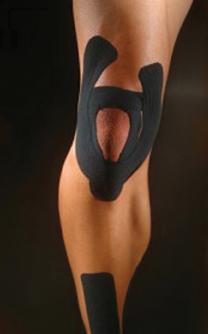Caught on Tape
If you watched any of the 2008 Beijing Olympics or the 2009 world track and field championships, you probably couldn't help but notice that dozens of those celestial bodies were adorned with brightly colored athletic tape in odd-looking, if not bizarre, patterns. So what's the deal? And why is this tape all the rage?
The tape is called kinesio tape, and it was developed in 1973 by a Japanese chiropractor named Kenzo Kase. What started out as a technique used by Japanese clinicians eventually spread globally and has really caught on in the last few years.
How It Works
The concept of kinesio taping is really quite simple: let the body use its natural powers to heal and perform better, primarily by improving muscle function. When a muscle is fatigued, tight, swollen, or inflamed, the space between the skin and the muscle is compressed. This compression reduces blood and lymphatic flow, and it increases pressure on pain receptors.
When applied to the skin, kinesio tape mechanically lifts the skin, increasing this space. Blood and lymph fluids can flow more freely, allowing waste products to be removed and nutrients to be delivered. All of this encourages better muscle function and faster healing of injured tissue. Moreover, the decreased compression of painful nerves reduces pain. Many athletes find this therapy quite amazing, though many use kinesio tape for performance enhancement rather than injury management.
Why It Works
Kinesio tape is relatively easy to use, but it still needs to be applied (at least initially) by a qualified physical therapist or athletic trainer. Depending on the specific goals, the tape may or may not be stretched when applied. For a weak muscle, the tape is applied from muscle origin to insertion. For a tight muscle, it is applied from insertion to origin. Four different shapes are used: "I," "Y," "X," and "fan shape." Generally, an "I" is used for tendons, "Y" is used for muscles, "X" is used for localized pain areas, and "fan shapes" are used for swollen regions.
If there is one drawback to kinesio tape, it's that there isn't a great deal of scientific research to support it. The purported benefits are mostly anecdotal. But, hey, it must work pretty darn well, I doubt that all of those world-class runners, throwers, and volleyball players are using kinesio tape simply because it's eye-catching.
John Sveen, PT, MS, SCS, CSCS, is a board-certified sports physical therapist, a certified strength and conditioning specialist, and is co-owner of Advanced Performance & Rehabilitation Physical Therapy in Bozeman.











